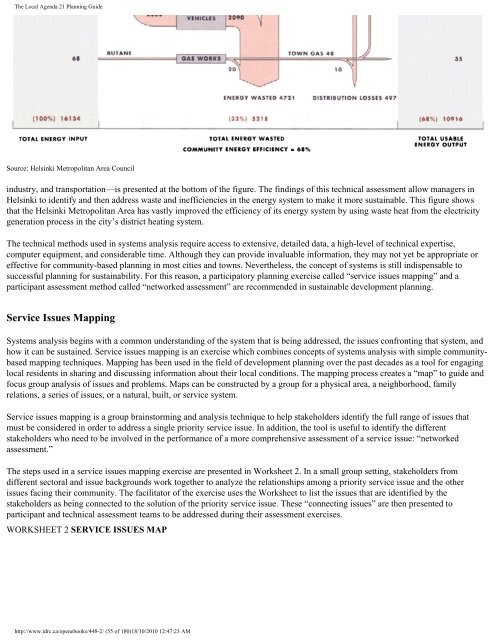The Local Agenda 21 Planning Guide - Democrats Against UN ...
The Local Agenda 21 Planning Guide - Democrats Against UN ...
The Local Agenda 21 Planning Guide - Democrats Against UN ...
Create successful ePaper yourself
Turn your PDF publications into a flip-book with our unique Google optimized e-Paper software.
<strong>The</strong> <strong>Local</strong> <strong>Agenda</strong> <strong>21</strong> <strong>Planning</strong> <strong>Guide</strong><br />
Source: Helsinki Metropolitan Area Council<br />
industry, and transportation—is presented at the bottom of the figure. <strong>The</strong> findings of this technical assessment allow managers in<br />
Helsinki to identify and then address waste and inefficiencies in the energy system to make it more sustainable. This figure shows<br />
that the Helsinki Metropolitan Area has vastly improved the efficiency of its energy system by using waste heat from the electricity<br />
generation process in the city’s district heating system.<br />
<strong>The</strong> technical methods used in systems analysis require access to extensive, detailed data, a high-level of technical expertise,<br />
computer equipment, and considerable time. Although they can provide invaluable information, they may not yet be appropriate or<br />
effective for community-based planning in most cities and towns. Nevertheless, the concept of systems is still indispensable to<br />
successful planning for sustainability. For this reason, a participatory planning exercise called “service issues mapping” and a<br />
participant assessment method called “networked assessment” are recommended in sustainable development planning.<br />
Service Issues Mapping<br />
Systems analysis begins with a common understanding of the system that is being addressed, the issues confronting that system, and<br />
how it can be sustained. Service issues mapping is an exercise which combines concepts of systems analysis with simple communitybased<br />
mapping techniques. Mapping has been used in the field of development planning over the past decades as a tool for engaging<br />
local residents in sharing and discussing information about their local conditions. <strong>The</strong> mapping process creates a “map” to guide and<br />
focus group analysis of issues and problems. Maps can be constructed by a group for a physical area, a neighborhood, family<br />
relations, a series of issues, or a natural, built, or service system.<br />
Service issues mapping is a group brainstorming and analysis technique to help stakeholders identify the full range of issues that<br />
must be considered in order to address a single priority service issue. In addition, the tool is useful to identify the different<br />
stakeholders who need to be involved in the performance of a more comprehensive assessment of a service issue: “networked<br />
assessment.”<br />
<strong>The</strong> steps used in a service issues mapping exercise are presented in Worksheet 2. In a small group setting, stakeholders from<br />
different sectoral and issue backgrounds work together to analyze the relationships among a priority service issue and the other<br />
issues facing their community. <strong>The</strong> facilitator of the exercise uses the Worksheet to list the issues that are identified by the<br />
stakeholders as being connected to the solution of the priority service issue. <strong>The</strong>se “connecting issues” are then presented to<br />
participant and technical assessment teams to be addressed during their assessment exercises.<br />
WORKSHEET 2 SERVICE ISSUES MAP<br />
http://www.idrc.ca/openebooks/448-2/ (55 of 180)18/10/2010 12:47:23 AM










